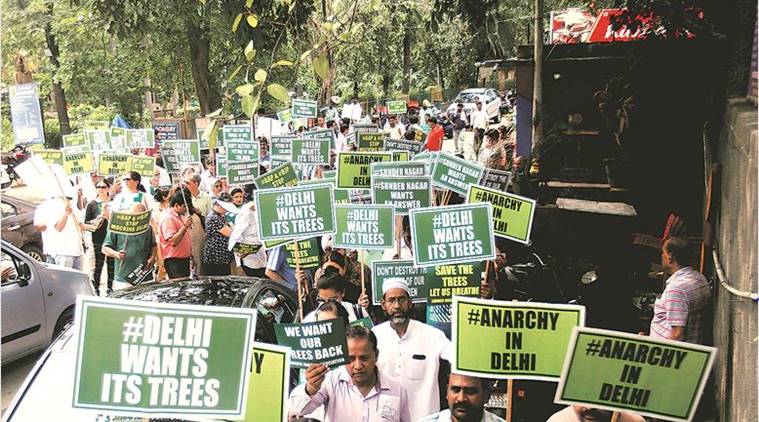No tree for a tree
Loss of mature trees cannot be made up by planting new ones. Forest Department shows how not to grow a forest.

A protest against tree felling in Sundar Nagar on Friday. (Express photo)
In the spontaneous protests that have erupted in Delhi over the felling of over 16,000 trees in government redevelopment yards, the response from the authorities seems to be: The numbers are exaggerated and, in any case, we’ll plant more trees than are being felled.
In a city with the most noxious air quality in the world, one would have thought that planners and politicians would strain every nerve and sinew to curb new development that adversely impacts Delhi’s air. In such a scenario, the numbers game is academic. It’s just as deplorable whether 11,000 or 16,000 trees are being chopped down.
But it’s the response that says, “In any case, we’ll plant more trees”, that I’d like to examine more closely: The entrenched notion that it’s feasible to compensate for the loss of mature trees by planting new ones. In India’s countryside, compensation for the diversion of forest land for “non-forest purposes” has been implemented through a series of laws that go back to the Forest Conservation Act of 1980, laws which have been tweaked a few times to try and make them more effective. At the heart of the matter lies the issue of whether it’s possible to make truly effective redress for cutting down a swathe of natural wilderness.
The policy culminated in the Compensatory Afforestion Fund (CAF) Act of 2016 and rests firmly on the assumption that it is possible to make effective redress by planting large numbers of trees on previously non-forested land. Compensation is reduced to a matter of counting trees.
It would be hard to find ecologists who would agree. An old forest is a whole lot more than the sum of its trees. How do you recreate a community of plants, fungi, microbes, insects and animals that are all part of a living jungle ecosystem? How many decades might it take? And how do you call into being a soil teeming with microorganisms and mycorrhiza that inhabit the humus that has taken 30,000 years to build up?
Such fundamental questions are awkward enough but consider this: The sole agency entrusted with carrying out compensatory afforestation is the Indian Forest Department. It is a bald and striking fact that no Forest Department in India has any experience or track record of doing any ecological restoration work of any kind. It is not part of the Department’s brief, has never been part of its historical role, and is not taught to foresters in their training. So to expect the Forest Department to achieve any kind of afforestation that is even remotely akin to a natural wilderness is like baying at the moon.
I practise a form of small-scale ecological restoration myself that I call “rewilding”, and it would be contrary if I suggested in any way that “rewilding” cannot be achieved. It can. But it needs tools and knowledge and techniques and, above all, a mindset that India’s Forest Departments do not possess, which is tragic, because it means that compensatory afforestation is doomed to remain an exercise in futility. It means that whenever forest land is acquired through due process for non-forest use, we will end up with compensatory afforestation that exists only on paper and with a net loss of forest in practice.
In a city like Delhi, the Forest Department must be thoroughly confused about what role to play in the centre of power and with so many horticultural agencies competing for its natural turf. The Forest Department plays little role in managing the green areas of Delhi, not even the Central Ridge, which is nominally under its control. But when it comes to compensatory afforestation, it is the Forest Department which implements the planting schemes and is charged with compliance under the CAF Act.
I have seen a few sad examples of compulsory afforestation in outlying villages in Delhi. Typically, the land that is made available for afforestation is the least arable, most degraded piece of land there is within the village revenue boundaries. I saw one tennis-court-sized plot that had been crammed with 2,000 saplings. Not one of them was a native tree, which means that none of them could be relied on to make it once watering and care were withdrawn. It was a very cynical exhibition of the Forest Department’s attitude towards compensatory afforestation: Tick all the right boxes in the form. And move on.
If you were to look at a Delhi Forest Department nursery to see how many “native” forest trees and shrubs they grow and stock, it will shock you: Maybe seven or eight species, at best. So why would anyone expect any results from their attempts to grow a natural forest (that will look after itself) on a tennis court in Outer Delhi?
Delhi’s Central Ridge — all 900 hectares of it — is like an instruction manual on what not to do if you want to grow a natural forest in Delhi. When it was first planted up around 1912-13, the Forest Department tried out eight species of trees. Not a single one was adapted to the thin, rocky soil that is found on the Ridge. As soon as watering was withdrawn, all the trees perished. Redemption — if it can be called that — came in the form of an invasive South American plant that was so successful it now dominates the Ridge to the virtual exclusion of everything else.
And we are expected to trust the government to grow compensatory forests on the outskirts of Delhi?
And we are expected to trust the government to grow compensatory forests on the outskirts of Delhi?
Krishen, an environmentalist, is the author of Trees of Delhi
For all the latest Opinion News, download Indian Express App






































No hay comentarios:
Publicar un comentario